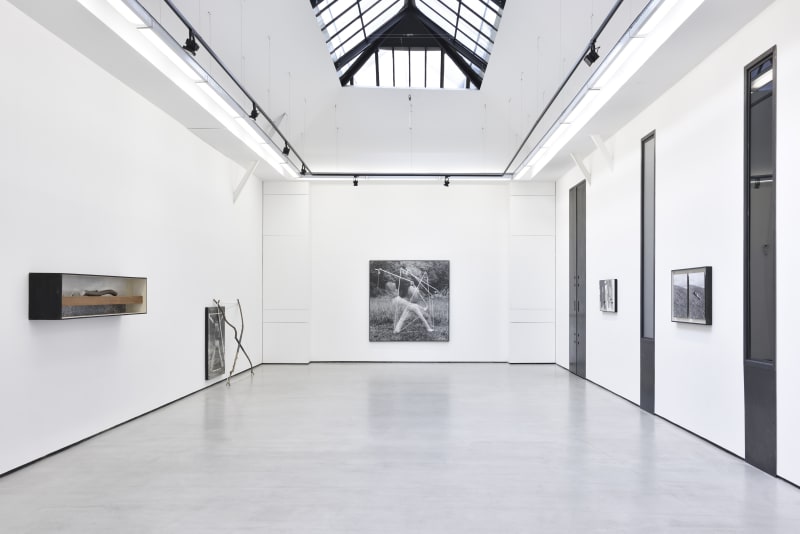After an initial collective exhibition dedicated to Japanese conceptual photography of the 1970s, the Galerie Christophe Gaillard is pleased to present, for two solo exhibitions not seen in France since the 1980s, the work of Masafumi Maita and that of Masaki Nakayama.
MAITA
A pioneer artist of the Japanese conceptual art scene of the 1970s, Masafumi Maita (1944–2009) devises systems that question the role of images and the limits of the representation of reality through photography. Maita plays on discrepancies and variations between the natural and contemplative subject that he photographs, the reality that he records (views of forests, beaches, and mountains devoid of any human presence) and the serial and arbitrary operation that he repeats within the image.
In nine photographs, each of the Flow ensembles (1976) stages the artist, facing the ocean, placed at the centre of a rectangle traced on the ground, showing the various phases of the methodical torsion of a lead rod. According to a predefined protocol, the artwork suggests a form of inventory of gestures and possibilities of inscription of the body in space. Photography records and narrates a performance: it falls within a new temporality.
“The essence of his idea is a consciousness of time” writes Japanese critic Yusuke Nakahra. With the Untitled (1979) series of landscapes in black and white marked by the artist’s hand, Maita accentuates the phenomena of discrepancies. A discrepancy between the landscape and simple geometric shapes, triangle, circle, and square traced in dotted lines on the negative; between the subject seen and the gaze that we bring to bear on it. A discrepancy between two temporalities, that of the real that has been captured and that of the gesture that alters the image and remains active.
Maita developed this research in installations, introducing objects and then sculptures into them, entering into conversation with his photographs. “Spatially,” writes Yusuke Nakahra, “the photographic image and the real objects appear continuous, but we feel as though we are facing two different temporalities – the present and the past. The real objects always show the present time while the photographic image shows the past. […] This difference is decisive. Combining the photo and real objects, the artist brings our awareness of time into vivid focus. […] It is the difference between perception and memory. In other words, Maita’s work consists of two elements – the perception and the memory.”
NAKAYAMA
Starting out as a woodworker-sculptor, since the 1970s Masaki Nakayama (1945) has consistently brought together in his installations the action of his own body, recorded through photography or drawing, and the confrontation of these images with objects. With the major series Body Scale, which he began in the 1970s and continues to update, Nakayama attempts to approach the world by using his body as a key scale of measure. Using a vocabulary of simple geometric shapes and the body as the primary tool in his installations, the Japanese artist falls within the lineage of some of the major figures of the international arts scene of his generation, such as Bruce Naumann and his Wall-Floor Positions (1968) in the United States or Franz Erhard Walther in Germany from the 1960s onwards.
“It has been over 40 years since I began my Body Scale works, which use the human body as their subject. While these works have different subtitles, the fundamental theme has remained unchanged, and I continue to create works on this theme today. These works are not preoccupied with the structure or size of the human body, nor are they predicated on some philosophical ‘theory of the body’. These are merely elements that have been incidental to the composite whole. […] For example, what lies between the real space of my active body and the real space of what is captured in my photographs is not a distance, but the discrepancy between overlapping existences in a multi-layered space.
With this, a mutually harmonious relationship is born. This is where my perspective lies. It is, in other words, this concept of the
multi-layered space of the human being that I refer to with my title Body Scale.” (Masaki Nakayama)
In association with Yumiko Chiba Associates (Tokyo, Japan).
Bio
Masafumi Maita (1944–2009) was born in Manchuria (China); he studied in Paris (1971–1973) then lived and worked in Japan. Since the 1970s, he has questioned and reinvented his medium – photography – in relation to objects, then sculpture. His works have been exhibited worldwide, particularly at the Venice Biennales of 1976 and 1986, and belong to numerous public collections, notably in Japan (The Utsukusi-ga-hara Open-Air Museum, Nagano; Open-Air Museum of Sculpture, Ube; Museum of Modern Art, Kamakur; Museum of Modern Art, Toyama; Yokosuka Museum of Art, Kanagawa, etc.), France (Collection Pinault; Centre National des Arts Plastiques, Paris; Musée d’Art Moderne de la Ville, Paris; Musée d’Art Moderne et Contemporain, Strasbourg; Musée Cantini, Marseille; FRAC Champagne-Ardenne), Italy (MuSaBa, Parco Museo Santa Barbara, Mammola), and the United States (Museum of Fine Arts, Houston; The State Foundation on Culture and the Arts, Hawaii).
Masaki Nakayama was born in 1945 in Kofu, Japan, where he now lives and works. A professional sculptor, Nakayama graduated from the Komagome School in Tokyo. In his installations and photographs, he uses his own body as the determining scale of his work. His works have mainly been exhibited in Japan, France, Poland, and the Czech Republic. They are conserved in Japan at the Yamanashi Prefectural Museum of Art (Kofu), the Yokohama Civic Art Gallery (Kanagawa), as well as at the Urawa Art Museum
